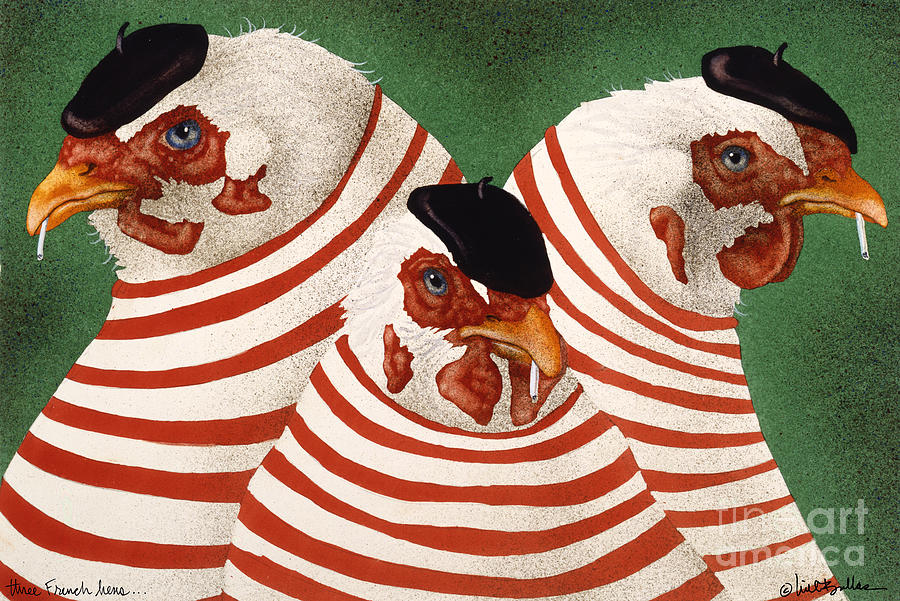What happens to me when I cross the Piscataqua and plunge rapidly into Maine at a cost of seventy-five cents in tolls? I cannot describe it. I do not ordinarily spy a partridge in a pear tree, or three French hens, but I do have the sensation of having received a gift from a true love. And when, five hours later, I dip down across the Narramissic and look back at the tiny town of Orland, the white spire of its church against the pale-red sky stirs me in a way that Chartres could never do. It was the Narramissic that once received as fine a lyrical tribute as was ever paid to a river—a line in a poem by a schoolboy, who wrote of it, ‘It flows through Orland every day.’ I never cross that mild stream without thinking of his testimonial to the constancy, the dependability of small, familiar rivers. — E. B. White
SONGS about HENS and CHICKENS:
- Funky Chicken by Rufus Thomas (rock): https://www.youtube.com/watch?v=8lCI63H1neY
- Chicken Dance Song (polka/line dance tune): https://youtu.be/r3z54SZsLsA
- Chicken Song by J Geco: https://www.youtube.com/watch?v=msSc7Mv0QHY
- Chicken in Black by Johnny Cash (country): https://www.youtube.com/watch?v=DTP9__vi3d4&feature=youtu.be
- Chicken Fried by Zac Brown (country): https://www.youtube.com/watch?v=e4ujS1er1r0&feature=youtu.be
- Five Little Chicks by Super Simple Songs (childrens song): https://youtu.be/FSZ9Wy0o4ww
- The Hen by HeyKids (childrens song): https://youtu.be/O5CB4BKhxKs
- Twelve Days of Christmas with Olivia & Audre (country version): https://youtu.be/CcbVImGey1M
The Hens — Elzabeth Madox Roberts
The night was coming very fast;
It reached the gate as I ran past.
The pigeons had gone to the tower of the church
And all the hens were on their perch,
Up in the barn, and I thought I heard
A piece of a little purring word.
I stopped inside, waiting and staying,
To try to hear what the hens were saying.
They were asking something, that was plain,
Asking it over and over again.
One of them moved and turned around,
Her feathers made a ruffled sound,
A ruffled sound, like a bushful of birds,
And she said her little asking words.
She pushed her head close into her wing,
But nothing answered anything.
Symbolism of French Hens — Darlene from Bonjour blog, full article: https://bonjourdarlene.com/2018/11/16/three-french-hens/
One belief is that the lyric from the popular Christmas carol refers to docile Faverolles, a French breed of chicken that is a favorite with young children because they make good pets.
But there are other theories. According to Catholic Straight Answers, the three hens “signify both the gifts of the Magi (gold, frankincense, and myrrh), and the three theological virtues of faith, hope, and charity.”
About French Hens — Bob Montgomerie from American Ornothological Society: (full article:https://americanornithology.org/three-french-hens/)
… The song originated in an 18th century memory game, celebrating an annual period of drunkenness and merrymaking sandwiched between two religious feasts. Many of those twelve days are about birds that were prized for the table. In mediaeval England, this period following Christmas was presided over by the Lord of Misrule and in Scotland by the Abbott of Unreason …
… On day 2, the TURTLE DOVES were French hens in one 1877 version, and the FRENCH HENS on day 3 were once ‘fat hens’ in 1864, and turtle doves in 1877. There’s a theme here as the first 3 birds were highly prized for the table, an excellent start to a period of feasting.
But why ‘French‘ hens? The Latin word for chicken is gallus and, as a result, the scientific name is Gallus gallus. In Roman times, France was Gaul, and people who lived there were Gallic. It seems that the simple word association between the homonyms Gallus and Gallic irrevocably associated the fowl with France. Indeed, a rooster was often a decorative ornament on church bell towers in France during the Middle Ages, and the Gallic Rooster was an important symbol during the French Revolution.
But also, when the Twelve Days rhyme was written, French hens were a prized table bird in both France and England. The breed Bresse Gauloise, for example, was sometimes called the ‘queen of poultry and the poultry of kings’. This breed originated in France in the late 16th century. La Fleche is also an ancient French breed from the Loire region of western France, and was renowned for its delicate flesh. During the 16th century hens from France were a luxury import from France. In the 19th century, the Houdan, another old breed from west of Paris, was one of the main meat breeds of France, and was imported to North America in 1865…

